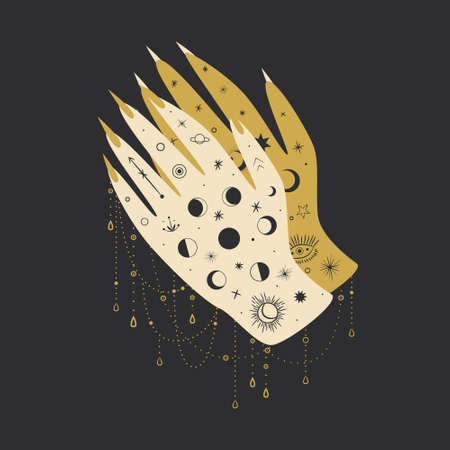1. Introduction to Ritual Tools in British Paganism
Within the diverse landscape of British Paganism, ritual tools hold a distinctive and time-honoured place in both communal and solitary practice. These objects—ranging from the iconic athame to the ceremonial chalice—are not mere props but are imbued with deep symbolic meaning and practical function. Historically, many of these tools can trace their origins back to pre-Christian Britain, where ritual implements were used in Druidic rites, folk traditions, and early magical practices. Over centuries, these artefacts have evolved and been reinterpreted by various Pagan groups such as Wiccans, Druids, and eclectic practitioners across the UK. Today, they serve as focal points for directing energy, honouring deities (with the moon often being central), and reinforcing connections to Britain’s rich spiritual heritage. Exploring the use and significance of these tools provides insight into how ancient customs adapt to contemporary spiritual needs while retaining their uniquely British character.
2. Symbolism and Craft of the Athame
The athame, a ritual dagger or knife, holds a central role in British Pagan practices, particularly within Wicca and other modern traditions. Unlike a weapon, the athame is primarily a tool of will and direction, often used to channel energy, cast circles, and define sacred space during lunar rites. Its significance is deeply rooted in both symbolism and craftsmanship—qualities that intertwine with the moon’s phases and the broader British landscape.
Symbolic Associations of the Athame
Within British Pagan ritual, the athame represents the element of Air or Fire, depending on tradition. It embodies masculine energy and is often paired with the chalice (representing feminine qualities) to symbolise the union of opposites. The athame’s blade, usually double-edged, stands for discernment and intention—essential qualities for practitioners aligning their work with lunar cycles.
Athame Symbolism Table
| Aspect | Symbolism | Lunar Connection |
|---|---|---|
| Blade (Double-Edged) | Discernment, Willpower | Full Moon (Clarity) |
| Handle Material | Connection to Nature/Ancestors | Waxing Moon (Growth) |
| Direction (Pointing) | Channeling Energy | New Moon (Intention Setting) |
| Sacred Geometry/Engravings | Personal or Coven Identity | Any Phase (Continuous Practice) |
The Craftsmanship of Athames in British Paganism
The crafting of an athame is often regarded as an initiatory journey. In Britain, many practitioners source local materials such as English oak for handles or reclaimed steel for blades, embedding a sense of place into their tool. Some choose to commission blades from traditional blacksmiths in rural villages—a nod to historic crafts and local lore. Personalisation is key: engravings may include runes, lunar symbols, or family crests.
Cultural Considerations
The process of making or acquiring an athame typically involves ritual cleansing and dedication under a particular phase of the moon—most commonly during the waxing or full moon for empowerment. This practice echoes old folk customs where tools were ‘blessed’ under moonlight to ensure efficacy and protection. The respect for craftsmanship extends to how the athame is stored; it is rarely used outside sacred context and often wrapped in natural fabrics such as linen or wool, reflecting both practicality and reverence characteristic of British sensibilities.

3. The Chalice: Meaning, Materials, and Use
Within British Paganism, the chalice holds a deeply evocative role, acting as a vessel for both literal and symbolic transformation during ritual. Resonant with themes of receptivity, the Divine Feminine, and the cycles of the Moon, the chalice is often seen as representing the womb of the Goddess—a sacred container for life and spiritual renewal. This symbolism aligns closely with the lunar currents that permeate much of local Pagan practice, emphasising cycles, reflection, and intuitive knowledge.
Symbolic Resonance in Local Tradition
The chalice’s association with water—one of the four classical elements—underscores its importance in rites dedicated to cleansing, blessing, and emotional healing. In British covens and solitary practices alike, the act of filling the chalice is often synchronised with lunar phases: full moons might see it brimming with wine or spring water to invoke abundance or psychic clarity; new moons may find it holding dew collected at dawn for renewal rituals. The chalice thus becomes a focal point for drawing down lunar energy and honouring the cyclical nature of spiritual growth.
Common Materials and Craftsmanship
Traditionally, chalices used in British Paganism are crafted from materials believed to enhance their magical properties. Silver is favoured for its strong connection to the Moon, echoing its reflective quality and feminine associations; pewter and glass are also popular for their accessibility and tactile appeal. Some practitioners commission local artisans to create bespoke pieces adorned with Celtic knotwork or lunar motifs—an approach that roots the tool firmly within Britain’s artistic heritage while reinforcing its ritual significance.
Ritual Application: Community and Solitary Practices
In group settings such as open circles or coven gatherings, the chalice is often passed hand-to-hand as part of a shared libation—a tangible act of unity underpinned by hospitality and trust. In solitary rites, practitioners may use the chalice to receive moonlight directly or blend herbal infusions intended for personal healing or divination. Its presence on the altar serves as a constant reminder of the ever-turning wheel of nature and one’s place within it, especially when aligned with local lunar calendars and traditions unique to Britain’s diverse Pagan communities.
4. Lunar Phases and Their Significance in Ritual
The moon’s phases have long been integral to British Paganism, shaping the rhythm and intention of ritual practice. From the waxing crescent to the waning dark, each phase is believed to carry distinct energetic qualities that influence not only when rituals are performed but also how ritual tools—such as athames and chalices—are aligned and integrated within rites.
How Moon Phases Influence Ritual Timing
Ritual timing is often meticulously planned according to the lunar calendar. For instance, the new moon is traditionally associated with beginnings, making it an auspicious time for setting intentions or initiating new projects. Conversely, the full moon is seen as a period of heightened energy and spiritual power, ideal for manifestation and divination. Many covens across the UK schedule esbats—regular gatherings for magical work—around these key lunar points, ensuring that rituals are synchronised with the most potent celestial energies.
The Alignment of Ritual Tools with Lunar Energy
British Pagans frequently align their ritual tools with specific lunar phases to enhance their effectiveness. Athames may be consecrated under a waxing or full moon to imbue them with increasing power or clarity. Chalices, symbolic of water and receptivity, are often charged under a full moon, believed to amplify intuitive and emotional resonance. Below is a simple reference table illustrating common tool alignments during various lunar phases:
| Lunar Phase | Typical Ritual Focus | Tool Alignment |
|---|---|---|
| New Moon | Beginnings, setting intentions | Athame cleansing; chalice dedication |
| Waxing Moon | Growth, attraction | Athame empowerment; tool charging |
| Full Moon | Manifestation, divination | Chalice charging; scrying tools aligned |
| Waning Moon | Banishment, release | Athame used for cord cutting; chalice for purification rituals |
| Dark Moon | Rest, reflection | Tools stored or cleansed; minimal use in major rites |
The Integration within British Pagan Rites
The deliberate integration of lunar cycles into ritual practices reflects a deep respect for nature’s rhythms—a hallmark of British Paganism. Practitioners not only observe the moon’s influence on agricultural cycles but also weave its phases into personal and communal ceremonies. Whether working solo in the countryside or gathering in urban groups, aligning rituals and tools with the lunar calendar reinforces a sense of connection to both land and tradition.
Lunar Observance as Living Practice
This ongoing alignment with the moon ensures that ritual practice remains dynamic and responsive to natural cycles rather than static or arbitrary. In essence, British Pagans treat lunar observance not simply as symbolism but as an active component shaping every aspect of ritual life—from the timing of spellwork to the consecration of cherished tools.
5. Local Variations: British Traditions and Lunar Practice
British Paganism is far from monolithic, and nowhere is this more evident than in the local variations of lunar-aligned ritual practice. The connection between ritual tools such as athames and chalices with the moon takes on unique forms depending on the region, informed by centuries of folk customs and shaped by the landscape itself.
Regional Nuances in Tool Use
For example, in Cornwall, where tin mining left a mark on both terrain and culture, practitioners might incorporate locally sourced stones or metals into their ritual tools, believing these materials to be imbued with the land’s energy. In contrast, groups in the Scottish Highlands may favour wooden-handled athames crafted from native rowan or oak, thought to offer additional protection during esbat rituals held under unpredictable weather conditions.
The Influence of Folk Customs
Traditional British folk practices—such as wassailing in the West Country or well-dressing in Derbyshire—often blend seamlessly with Pagan lunar observances. Many covens and solitary practitioners adapt these customs to coincide with full moons or specific lunar phases. For instance, a chalice might be filled with cider instead of wine during a Somerset moon rite, honouring both local produce and ancestral tradition.
Landscape Shaping Ritual
The British landscape itself can dictate how lunar-aligned rituals are performed. Coastal communities might gather for esbats on windswept beaches, using sea water in their chalices to draw down the moon’s reflection. In contrast, those living near ancient stone circles such as Avebury or Castlerigg may conduct ceremonies within these sites, allowing the moon’s light to fall directly upon their ritual space—an interaction between tool, practitioner, and place that is deeply rooted in local identity.
This regional diversity ensures that while core beliefs about the moon and ritual tools are shared across British Pagan traditions, their expression remains intimately tied to community history, environment, and ongoing dialogue with the living land.
6. Contemporary Practice and Community Reflections
The relationship between ritual tools, lunar cycles, and British Paganism has not remained static; instead, it continues to evolve alongside the modern lives of practitioners. Today’s British Pagans are increasingly candid about adapting traditional practices to fit contemporary contexts, while still valuing the heritage and symbolism that athames, chalices, and lunar observances bring to their spiritual lives.
Modern Adaptations in Ritual Practice
Within covens and solitary circles alike, there is a clear trend towards pragmatism and inclusivity. Some practitioners speak openly about substituting traditional materials—such as using recycled or locally sourced items for chalices or athame handles—to align with environmental values. Others adapt the language of invocations, shifting away from archaic or gendered phrases to reflect present-day sensibilities and ensure everyone feels welcome within ritual space. The moon’s phases remain central, but working schedules around urban life means full moon gatherings might occur virtually or in communal spaces rather than remote woodland groves.
Language Use: Tradition Meets Innovation
British Pagans frequently discuss the words they use during rituals. Many prefer plain English or local dialects over imported ceremonial phrases, believing that authenticity is better served by expressing intentions in a way that resonates personally and culturally. Some groups even develop their own liturgical vocabularies, blending folklore with contemporary speech—a practice that roots ritual firmly in the here-and-now of British life while honouring its mystical lineage.
Community Voices on Relevance Today
Interviews and community reflections suggest that for many, the true power of ritual tools lies not in unchanging tradition but in their ability to foster connection—to land, to history, and to each other. The moon remains a potent symbol for cyclical change and reflection, regardless of whether one observes it from a city balcony or a rural stone circle. Ultimately, British Pagans see their craft as living and adaptive; by integrating modern values with ancestral wisdom, they ensure that athames, chalices, and lunar rites continue to inspire meaning and community in an ever-changing world.

